VECTORS.
The word vector comes from a latin word which means 'one who carries, one who takes, one who transports'. As you can see, we can translate it as the conductor, bearer,…
A vector is a piece, part, portion or segment of a line which indicates more than just its length or magnitude; it also indicates direction and sense.
From line X (this would be direction), we take a piece, a part or segment and we mark its length with letters A and B. Then, we draw an arrow to the right to indicate its sense.

Vectors are represented with letters to determine its magnitude (initial point and terminal point). In the previous example, the initial point of the vector is found in A and the terminal point is B. Vectors are represented with letters (first the initial point, then the terminal point) and an arrow above them to represent its sense:

Vectors can be written in just one uppercase or lowercase letter: 
Many people consider the words direction and sense to be the same. However, they are different. Direction is the line in which movement is created while sense indicates where this movement is performed (where we are going), to one side or the other.
Imagine a highway going from Irun to Madrid (and vice-versa, of course). In this case, we are referring to direction. Usually, a single highway can take you to different places. In other words, there can be more than two cities found in a highway. Nevertheless, there are two senses whenever we are traveling from one city to another: we are either going to Madrid or we are going to Irun. See the image below:
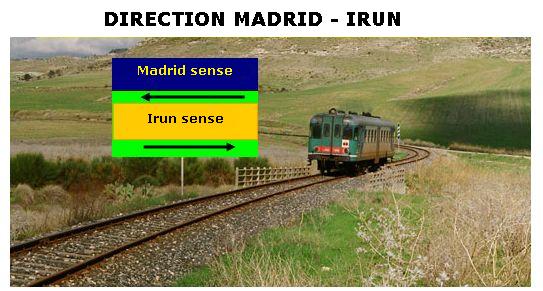
The train tracks (railroad) indicates direction. The train is either going on the sense of Madrid or the sense of Irún. There can be many directions (places where train tracks have been laid out) but there can only be two senses, no more.
8.11 In this exercise, you have some vectors you need to group:
1º those which have the same magnitude
2º those which have the same direction
3º those which have the same sense
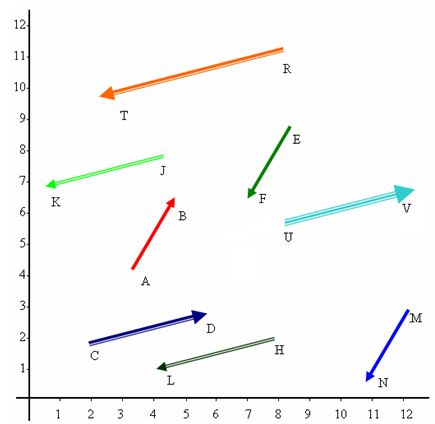
Answers: same magnitude:


same sense:

EXERCISES WITH VECTORS.
If vectors can be represented in graphics, we can also represent their sum graphically.
Adding vectors:
To add two or more vectors in a graph, we join their initial points just like you have it in F 1. As you can see, both coincide in point (0,0). Let's add these vectors:

The first vector has its origin (initial point) in (0,0) and its terminal point is in (2,2). The second vector  also has its origin (initial point) in (0,0) and its terminal point is in (5,2).
also has its origin (initial point) in (0,0) and its terminal point is in (5,2).
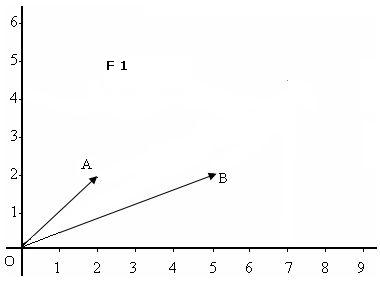
It is advisable for you to draw them in a coordinate axis. The sum can be performed in two ways:
a) graphically
b) adding their components
Once you have drawn the vectors in their corresponding locations, trace a line parallel to  starting from A and another line parallel to
starting from A and another line parallel to starting from B, as seen in F 2:
starting from B, as seen in F 2:
These two lines cut in point C. Join this point with the origin of both lines (initial point for both vectors) to form vector  . Its initial point is located at (0,0) and its terminal point is in (7,4). This is the result of adding
. Its initial point is located at (0,0) and its terminal point is in (7,4). This is the result of adding 
b) The terminal point of vector

is located at (2,2) and the terminal point of vector

is (5,2). The two values which define a point, in other words, the values of x and y are called components. If we add the components of x and y in an orderly fashion, we get (2+5,2+2) = (7,4). This is equal to the value we got previously in a graph.
8.12 Add vectors  and
and  graphically. Their lengths, directions and senses are shown in F 3 starting from point (1,2).
graphically. Their lengths, directions and senses are shown in F 3 starting from point (1,2).
Solution:
In F 3, we have located the two vectors we want to add at a point different from (0,0); they are located at point (1,2).
We will solve this graphically by tracing parallel lines for both vectors starting from A and B, as we did in the previous case. They cut at point C. We join this point with O to get the resulting vector from adding both vectors:
 , its coordinates correspond to point (8,6).
, its coordinates correspond to point (8,6).
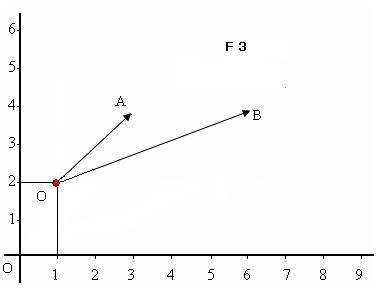
However, this answer is not correct because we have started from point (1,2). This means we need to subtract the components of points (8,6) and (1,2); (8,6) - ( 1,2) = (8 – 1, 6 – 2) = (7,4). You have these values represented in F 4:
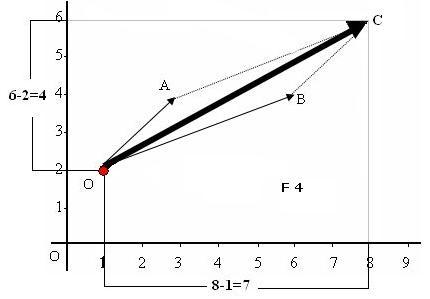
Fig. 5
8.13 In the first quadrant of a coordinate axis, draw two vectors and calculate their sum. Solve this using at least two different ways.
Adding the components, we get: (3+5, 5+2) = (8,7). However, this value does not originate from point (0,0) but from point (2,3). We need to subtract components (2,3) from components (8,7):